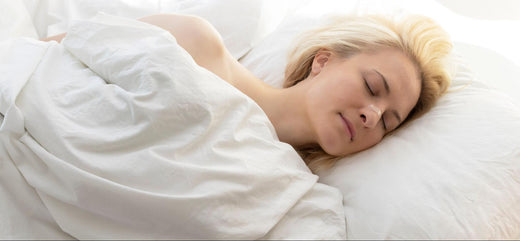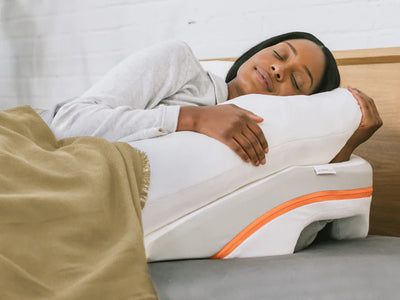
Related Product

Reflux Relief System
$249.99 USD
Say goodbye to nighttime Acid Reflux & GERD pain without sacrificing comfort.
Do Nasal Strips Work for Snoring? | Pros and Cons List
Share
Nasal strips are stiff fabric pieces worn over the bridge of the nose to help stop snoring. Breathe Right, in particular, is one of the most popular nasal strip brands on the market. Acting like a “spring-like” band, these nasal strips widen the nostrils to improve airflow through the nose. But how effective are these devices?
In this deep dive, we uncover the truth about nasal strips, examining possible use cases, benefits, limitations, and alternatives. Keep reading to discover whether Breathe Right and other nasal strips work for snoring.
Effectiveness of Nasal Strips
In a 2016 review, a third-year medical student at UC Irvine examined the effectiveness of nasal strips. Together with his team, they concluded that Breath Right and similar nasal strips could help reduce nasal obstruction. They also recommended patients explore nasal strips as a solution before seeking surgery.

Nasal Strips Use Cases
Snoring Reduction
While research has shown mixed results, some studies have found that Breathe Right and similar nasal strips do work to reduce snoring. These studies usually report effectiveness based on the participants’ opinions about whether there has been an improvement. In these cases, people have reported nasal strips to improve the frequency and severity of their snoring.
Athletes and Enhanced Breathing During Exercise
Nasal strips may also work to enhance breathing during exercise. In one small study, researchers examined a group of eight young, untrained male athletes. These men wore nasal strips during “all-out” intermittent exercise. The result? Nasal strips eliminated ventilator muscle fatigue and improved the athlete’s power output.
Nasal Congestion Relief
For people who suffer from the stuffiness and breathing difficulties of nasal congestion, nasal strips may work to reopen the nasal passageway for better sleep at night. In one recent study, people with chronic nasal congestion used Breathe Right and similar nasal strips nightly for two weeks. At the end of the trial period, participants reported that the nasal strips significantly improved their nasal congestion and sleep quality.
Nasal Strips During Pregnancy
Snoring during pregnancy is extremely common. According to the American Thoracic Society, more than half of pregnant women will experience frequent snoring during their pregnancy. Hormonal changes and weight gain can lead to nasal congestion and breathing challenges.
Nasal strips offer a non-medicated solution for snoring and congestion during pregnancy by facilitating breathing through the nose.
Nasal Strips and Sleep Apnea
Nasal strips may also help people with sleep apnea rest better at night. This sleep disorder is characterized by disrupted breathing patterns throughout the night. It can either be caused by the brain not signaling to the body that it needs to breathe (central sleep apnea) or a blockage in the airway (obstructive sleep apnea).
While nasal strips are not a cure for sleep apnea, they can help ease some symptoms of nasal obstructions. They can also aid in other sleep apnea treatments like continuous positive airway pressure (CPAP) therapy. One study found that participants who wore nose strips while undergoing CPAP therapy did not need as much pressure from the machine, making it more comfortable for the patients.
Combining Nasal Strips with Other Therapies
Along with CPAP therapy, snoring strips can be part of a broader management strategy for snoring. Lifestyle modifications like eating a healthy diet and exercising can help prevent snoring by preventing excess weight from blocking your airway. Changing your sleep position is also an excellent and easy preventative strategy. When you sleep on your side, it helps prevent your airway from being blocked. Positional pillows like MedCline’s sleep solutions offer gentle elevation to clear your airways.
Pros and Cons of Nose Strips

Nasal strips are affordable, accessible, easy to use, and come in different varieties and sizes. They’re also a non-invasive solution that may help prevent and reduce nasal congestion symptoms and snoring.
However, nasal strips do not work to treat breathing issues and sleep disorders like sleep apnea. They may also cause mild side effects, such as irritated skin, redness, and itching.
For another effective natural sleep solution, MedCline’s medically proven pillows. They can help address snoring and poor sleep patterns by keeping sleepers comfortably in the doctor-recommended side position. Made with adjustable memory foam stuffing, our seamless design features full body support and a patented arm pocket to keep sleepers elevated and comfortably in place.
How to Use Nasal Strips Correctly
When applying Breathe Right and nasal strips, wash your nose and dry it thoroughly to help the adhesive stick. Remove the strip from the adhesive liner and place it on the lower bridge of your nose. Press down on the strip, especially the ends, to ensure it’s secure.
To remove the nasal strip, wash your face with warm water and gently lift the strip on each side.
Alternatives to Nasal Strips
If you’re unhappy with how nasal strips work for you, other treatments are available. Alternative remedies for snoring and nasal congestion include the following:

- Run a humidifier in your bedroom while you sleep.
- Use a nasal decongestant or saline spray to help with short-term congestion.
- Incorporate mouth exercises into your daily routine. These strengthen the tongue and soft palate and reduce snoring.
- Place internal nasal dilators inside your nostrils for better airflow and sleep quality.
- Wear an oral appliance while you sleep to keep your airway open.
- Switch your sleep position to the side. Elevating your head with an anti-snoring pillow, like MedCline’s sleep wedges, can also help.
Conclusion
Research shows that nasal strips may reduce snoring by creating less air resistance in the nasal passages. While you should not use these devices to address complex breathing issues like obstructive sleep apnea, they may still help aid in treatment solutions like CPAP therapy. Your sleeping position can also affect whether you snore. Research shows that sleeping on your side can decrease the severity of snoring and other sleep apnea symptoms.
At MedCline, we want to help you get a better night’s sleep in the least invasive way possible. Our anti-snore pillows are backed by science and offer safe, non-medication solutions. Made with adjustable memory foam stuffing, our seamless design features full body support and a patented arm pocket to keep sleepers comfortably open to keep airways clear and open.
For more information about how our sleep wedges can help with snoring, head to our MedCline FAQs or contact our team of Sleep Specialists today!

Resources
"UCI Health Review of Over-the-counter Nasal Dilators Finds Them Effective." UCI HEALTH, 30 Jun. 2016, www.ucihealth.org/news/2016/06/study-compares-nasal-strips.
R, Dinardi, et al. "External Nasal Dilators: Definition, Background, and Current Uses." International Journal of General Medicine, vol. 7, 2014, https://doi.org/10.2147/IJGM.S67543.
Tong, T K., et al. "Effect of Nostril Dilatation on Prolonged All-out Intermittent Exercise Performance." The Journal of Sports Medicine and Physical Fitness, 2001 Jun;41(2):189-95. PMID: 11447361.
Schenkel, Eric J., et al. "Effects of Nasal Dilator Strips on Subjective Measures of Sleep in Subjects with Chronic Nocturnal Nasal Congestion: A Randomized, Placebo-controlled Trial." Allergy, Asthma & Clinical Immunology, 2013, https://doi.org/10.1186/s13223-018-0258-5.
"Preventing Sleep Problems and Treatment of Sleep-disordered Breathing in Pregnancy: Part 2." American Thoracic Society, www.thoracic.org/patients/patient-resources/resources/sleep-and-pregnancy-pt2.pdf.
Schönhofer, Bernd. "Effect of Nasal Valve Dilation on Effective CPAP Level in Obstructive Sleep Apnea." Respiratory Medicine, vol. 97, no. 9, 2003, pp. 1001-5, https://doi.org/10.1016/s0954-6111(03)00125-2.
Related Product

Reflux Relief System
$249.99 USD
Say goodbye to nighttime Acid Reflux & GERD pain without sacrificing comfort.


